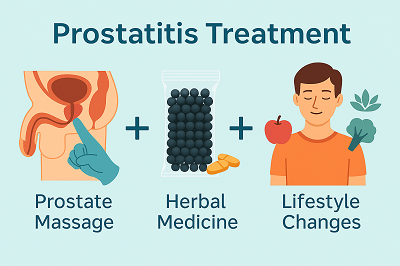Prostatitis and Prostate Massage: Why It Works Better When Combined with Other Treatments
Prostate massage is a technique that involves gently stimulating the prostate gland—usually via the rectum—to promote drainage of inflammatory fluid, improve local circulation, and relieve swelling. The practice isn't new. In fact, it is been used for decades in both Western urology and Traditional Chinese Medicine to manage chronic prostatitis, especially when antibiotics or anti-inflammatory drugs fail.

Many men turn to prostate massage when symptoms like these become persistent:
- Pelvic pressure or aching
- Pain between the anus and scrotum
- Frequent urination or incomplete emptying
- Pain during or after ejaculation
- Chronic testicular or groin discomfort
But here's the key question: Is prostate massage alone enough to treat the root of the problem?
The Limits of Massage-Only Treatment
While some men report short-term relief after prostate massage, it's rarely a complete or lasting solution—especially for those with Chronic Pelvic Pain Syndrome (CPPS) or non-bacterial prostatitis, which make up over 90% of cases.
Let's break down why:
1. Massage Relieves Pressure, Not the Cause
Prostate massage helps release trapped fluid or congested secretions. This may relieve the feeling of "fullness" or reduce pressure, but it doesn't address underlying inflammation, infection, or nerve dysfunction.
2. Temporary Effects = Frequent Relapse
Men often find themselves needing repeated massages just to maintain relief. Once they stop, the symptoms creep back—suggesting that massage is managing symptoms, not resolving the disease.
3. Not Suitable for All Types of Prostatitis
If your prostatitis is bacterial in nature, especially acute bacterial prostatitis, prostate massage might even make things worse by spreading bacteria into the bloodstream. That’s why doctors usually advise against massage in active infections.
Why Combination Therapy Makes a Difference
Treating prostatitis successfully often requires a multidimensional approach. Why? Because it's not just a simple infection—it is a complex condition involving:
- Inflammation of the prostate and surrounding tissues
- Pelvic floor muscle tension or spasms
- Possible microbial imbalance
- Psychological stress (which worsens symptoms)
- Blood flow stagnation in the lower pelvis
Massage Helps With:
- Local drainage
- Reducing congestion
- Improving microcirculation
But You Also Need to:
- Fight systemic inflammation
- Restore microbial balance (especially if antibiotics failed)
- Relax tense pelvic muscles
- Support tissue healing
- Prevent symptom recurrence
That's where natural, whole-body approaches like Traditional Chinese Medicine come into play.
Diuretic and Anti-inflammatory Pill: A Holistic Solution
The Diuretic and Anti-inflammatory Pill is a modern herbal formulation based on classic TCM principles. It targets not just the symptoms, but the underlying causes of chronic prostatitis.
Key Benefits:
- Clears heat and toxins from the urinary tract
- Promotes blood circulation and reduces pelvic congestion
- Alleviates swelling and inflammation in the prostate
- Relieves painful urination, urgency, and frequency
- Improves sperm health and ejaculatory function
- Supports recovery from epididymitis and seminal vesiculitis
Most importantly, it helps prevent recurrence—which is the biggest frustration for most prostatitis sufferers.
Don't Forget Lifestyle: The Third Piece of the Puzzle
While prostate massage and herbal therapy form the core of effective treatment, lifestyle matters too. Many men with prostatitis benefit from making a few daily adjustments:
Stretch and relax your pelvic floor
Pelvic tension contributes to chronic discomfort. Techniques like deep breathing, yoga, or physical therapy focused on the pelvic area can make a big difference.
Stay hydrated
Frequent urination is common—but reducing water intake actually makes it worse. Proper hydration helps flush inflammation from the urinary tract.
Eat anti-inflammatory foods
Cut back on spicy, fried, and processed foods. Add more fresh vegetables, omega-3 fats (like fish or flaxseed), and herbal teas.
Reduce prolonged sitting
Sitting too long puts pressure on the perineum and prostate. If you work at a desk, try standing up every hour or use a cushioned seat.
Best Treatment Plan: Integration, Not Isolation
Here's what a smart prostatitis recovery plan might look like:
Step | Action |
| 1 | Prostate massage 1–2 times a week under medical supervision |
| 2 | Take Diuretic and Anti-inflammatory Pill daily for 1–3 months |
| 3 | Adjust diet and reduce stress triggers |
| 4 | Use warm sitz baths or heat therapy to relieve pelvic tension |
| 5 | Monitor symptoms and track progress weekly |
Final Thoughts: Prostate Massage Isn't a Magic Bullet
If you've tried prostate massage and felt only short-term relief, you're not alone. It has its place—but real healing comes from combining it with the right internal therapies and supportive habits.
Whether you have been struggling with chronic prostatitis for months or years, it is not just about "draining the gland"—it's about restoring balance, clearing inflammation, and preventing it from coming back.
And for that, the Diuretic and Anti-inflammatory Pill offers a trusted, all-natural option worth considering.
Need help getting started?
Learn more about our natural treatment: www.diureticspill.com
Read patient stories, FAQs, and expert insights on managing chronic prostatitis



